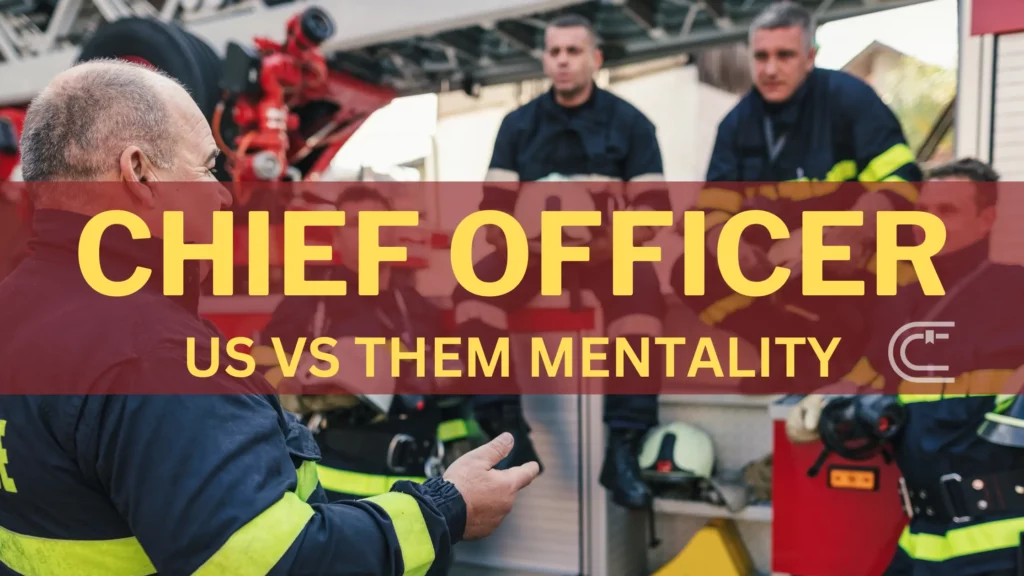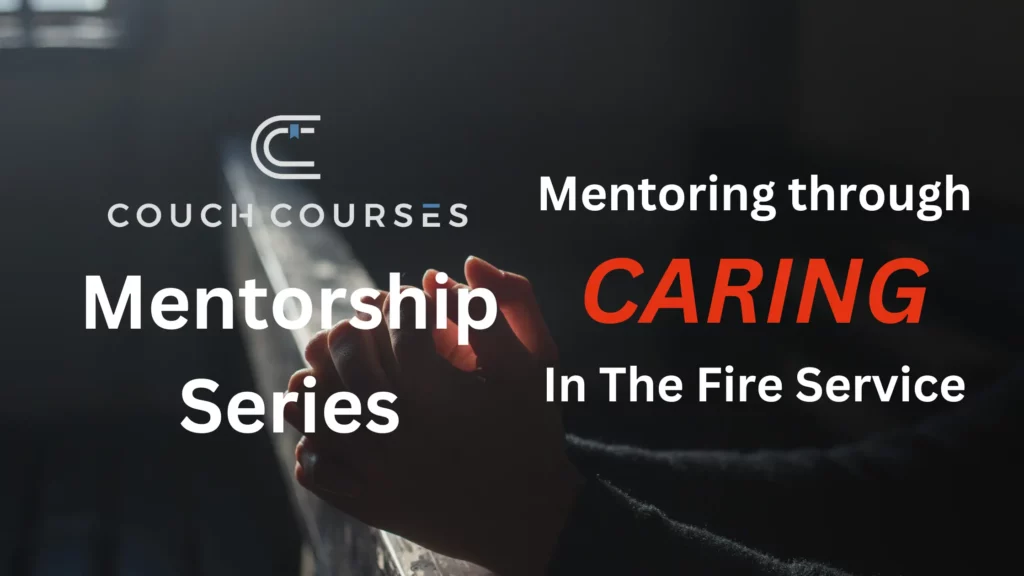Chief Officer: Us vs Them Mentality

Who likes playing ‘us vs them ‘? No one.
I recently had a conversation with a former colleague who told me he was retiring. He is an assistant fire chief and has only been in the position for about a year. Suspecting I already knew the reason, I asked him why he was retiring after only a year in his new role. He told me he was tired of the “us versus them” mentality.
Sadly, I knew exactly what he was talking about. All too often the relationship between the chief officers and the rank and file becomes an us versus them situation.
Of course, this is not the case in every situation, but I have seen this quite often in my career. As a former fire chief, it’s very frustrating. Just because someone chooses to promote up and wear a white shirt, or have three or more bugles on their collar, does not make them the enemy.
As a chief officer, the overall mission does not change from that of a front-line firefighter, but many aspects of the job do.
Responsibility misunderstood
A fire chief is in a similar position to that of a first-line officer, that is they are senior management within the community, but also the bridge to the labor group.
As a member of the senior management team, they have a responsibility to the entire community to provide excellent service for the least amount of money possible. Sometimes this means working with town officials and other department heads to plan for capital expenditures, staffing, or other types of things needed to run a fire department. This is part of the process of “being on the balcony” as described by Heifetz and Linsky (2017).
This behind-the-scenes planning can sometimes be translated as the “chief doesn’t care about us”, or “the chief doesn’t fight for what we need”. Because we can’t see the process it becomes easy to villainize someone when we think they don’t care about us or care about what we need to do the job safely.
Working hard to put their people first
Having spent 15 years as a chief officer, the last 11 as chief of department, I met with other chiefs regularly to discuss all types of issues, including the relationships between management and labor.
To be fair, there are chief officers who view the labor group as the enemy, but most chief officers work hard to put their people first. This means the chief works hard behind the scenes to secure funding for safe equipment, adequate staffing, and other items such as decontamination equipment. Chiefs write policies with the intent of keeping their people safe in a very dangerous profession.

Consider a scenario
A fire chief wants to implement a mandatory wellness program for their fire department. The program he has outlined includes NFPA-compliant physicals and a physical fitness program for all members. The program outlines the procedures if someone doesn’t pass their physical, including taking people off the line who are in imminent danger with a life-threatening condition. In this scenario, a person may end up having to separate from the department because they are no longer considered fit for duty.
The cynic among us might say “The chief is just doing this to get rid of so and so”, or “They’re just implementing that to get back at us”. Choose your phrase.

Now let’s look at reality.
- The cost of firefighter injuries annually is estimated to be over $5 billion (Butry et al., 2019).
- There are more than 20,000 fire ground injuries annually (USFA, 2020)
- Better than 70% of firefighters in the US are overweight and more than 30% are considered obese (Jahnke et al., 2017).
- Sudden cardiac death or related cardiac incidents are still a leading cause of line-of-duty death (Smith, Haller, et al., 2019).
- Cardiovascular disease among firefighters remains high for multiple reasons, including poor fitness levels (Smith, 2016).
As a fire chief, I had to learn to use data to predict, budget, and plan for the future. Given the scenario I outlined and the two reasons I gave for a fire chief to implement the mandatory wellness program, which is more plausible?
Working together
I used the previous scenario as an example of a fire chief trying to implement a program where the intent may be misconstrued as one of vindictiveness or pettiness. But if you look at the scenario objectively, it becomes clear the program has value. The point? We don’t need to be enemies. Let’s work together and make the fire service even better than it is now!
Some points to help us do that:
1. Communicate
For those that have read my work before you’ll see communication is a common theme.
If you are a chief officer, try and keep the rank and file in the loop. Obviously, you cannot talk about everything, but most things are not top secret. Try and spread the word about where you want the organization to go and why.
If you are a firefighter, ask questions. You are a stakeholder in the organization and have a right to know what the plan is.
2. Empathize
Empathy is understanding another person’s feelings or position on an issue. It doesn’t mean agreement, but rather understanding why someone thinks the way they do.
If you are a chief officer, work to understand why a firefighter or the labor group feels the way they do about an issue.
If you are a firefighter, seek to understand where the chief officer is coming from or why they are thinking the way they are.
3. Be your own person
One of the best pieces of advice I ever got when I started working in the fire service was to form my own opinion of people. There are always going to be people pushing their own opinions of other people. We all have agendas and biases whether we are aware of it or not. The last thing we need to do is jump on the bandwagon based on someone else’s agenda or bias. This can be tough because of peer pressure, but remember, leadership is an action, not a title. You can lead from the middle or even the bottom.
4. Avoid group think
We all need to evaluate programs and people using our critical thinking skills. Groupthink occurs when a conclusion is reached without doing this.
Think of the scenario I outlined earlier. If the conclusion is “the chief is just trying to get rid of people”, what critical thinking has gone into the argument to help reach that conclusion?
5. Stay focused
It is easy to get caught up in everything that surrounds us during our day. I think this is even more true for firefighters because we spend so much time together and group dynamics play a part in how we all think.
Try and focus on what your job is and what your role in carrying out the organization’s mission is. If everyone worked a bit harder on making themselves a bit better each day instead of worrying about someone else the organization would grow stronger.
Improve everyday
Some of these action items are difficult, and I’d be lying if I said I followed them every day of my career. As I look at my career in the rearview mirror, I do wish I had been better in some of these areas, especially communication. If we think we are good at communication, we probably aren’t. The good thing is we can keep trying to be better each and every day.
Takeaway
In all my time as a chief officer, I never met a chief officer who was trying to “get back at” their people or “get rid of” people with a policy or initiative.
As a chief officer, one of the things that kept me up at night was the fear of losing a firefighter. We may not outwardly show it, but we do care about our people, and the fear of losing one, particularly if it was preventable, can be overwhelming.
Both chief officers and firefighters need to do a better job of not making each other the enemy. We all share the same mission, and we all want everyone to go home safely at the end of the day or shift. Brotherhood and sisterhood are not determined by the color of our shirts!
References
Butry, D. T., Webb, D., Gilbert, S., & Taylor, J. (2019). The economics of firefighter injuries in the United States (NIST Technical Note, 2078). U.S. Department of Commerce.
Heifetz, R.A., & Linsky, M (2017). Leadership on the line: Staying alive through the dangers of change. Harvard Business Review Press, Boston, MA
Jahnke, S. A., Poston, W. C., Haddock, C. K., & Jitnarin, N. (2017). Health, wellness, and readiness in the fire service. International Fire Service Journal of Leadership & Management, 11, 7-13.
Smith, D. (2016). Understanding and preventing sudden cardiac events in the fire service. International Fire Service Journal of Leadership, 10, 51-57.
Smith, D. L., Haller, J. M., Korre, M., Sampani, K., Grossi Porto, L. G., Fehling, P. C., & Kales, S. N. (2019). The relation of emergency duties to cardiac death among US firefighters. American Journal of Cardiology, 123(5), 736-741.
US Fire Administration. (2020). National Fire Department Registry quick facts.
Recommendations
- Fire Officer I Classes
- Fire Officer II Classes
- Fire Officer III Classes
- Fire Officer IV Classes
- The Role of the Fire Officer – Blog
- Fire Service Culture – Blog





